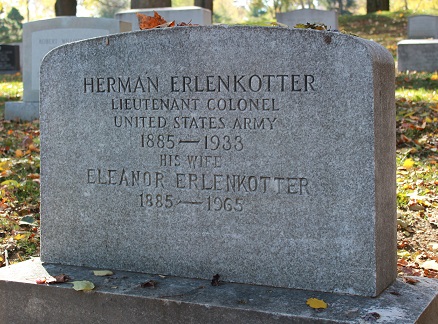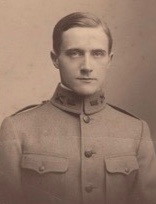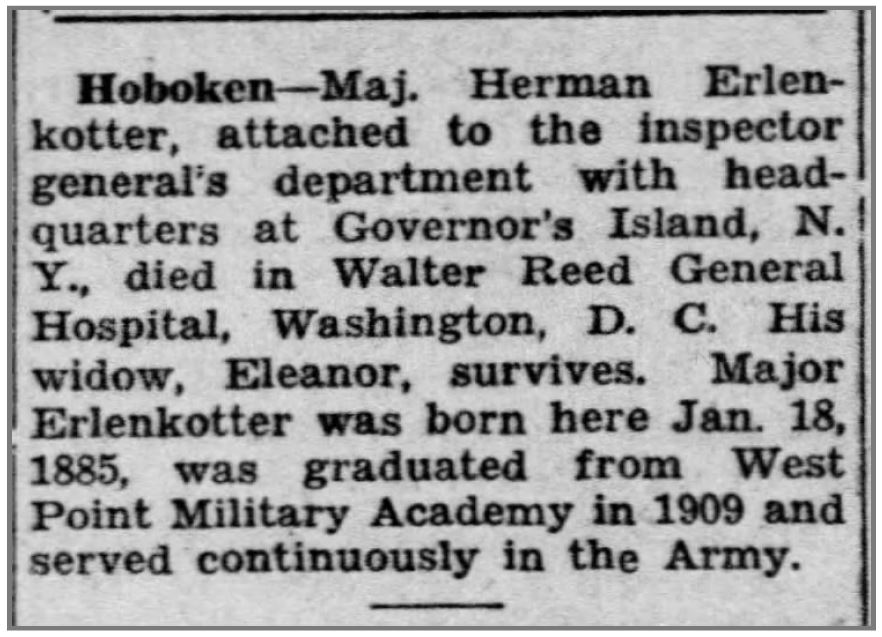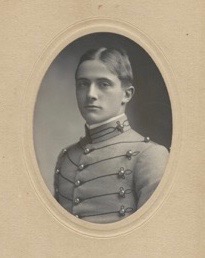From 13 December 1915 to 1 September 1917 Lt. Erlenkotter was with the 1st Field Artillery at Schofield Barracks, Territory of Hawaii. Next he had assignments at Camp Zachary Taylor, Kentucky; Camp Jackson, South Carolina; Fort Sam Houston and Camp Stanley, Texas; and Fort Sill, Oklahoma. He was a battalion commander in the 76th Field Artillery at Fort D. A. Russell from 16 June 1923 to 15 May 1924. Following an assignment as Assistant Chief of Staff, G-4, at Quarry Heights, Canal Zone from 25 August 1925 to 15 June 1928, he commanded the 2nd Battalion, 4th Field Artillery at Fort Robinson, Nebraska until 30 June 1930, and served as post executive officer there. Maj. Erlenkotter then was Assistant to the Department Inspector General and Acting Department Inspector at Manila, Philippine Islands from 2 October 1930 to 24 September 1932. His last assignment was as Acting Corps Area Inspector, Headquarters 2nd Corps Area, Governors Island, New York.
Major Erlenkotter graduated from the Command and General Staff College in 1923, and from the Army War College in 1925. He was detailed to the General Staff Corps from 30 June 1925 to 23 June 1928. A letter from Gen. Douglas MacArthur gives an outline of his broad and faithful service to his country, and concludes:
"Colonel Erlenkotter was an able officer of keen, analytical mind, and independent judgement. Thoroughly versed in his profession, dependable, conscientious, and resourceful, he performed the various duties assigned him in a highly efficient and painstaking manner. His death is deeply regretted."
According to a family tradition, Herman was among those who introduced the sport of lacrosse to the U. S. Military Academy. He had played lacrosse at Stevens, and had scars on the top of his head from blows with lacrosse sticks. In 1909 he was captain of the undefeated Army lacrosse team. Herman was a "high handicap" polo player. One of his most cherished accomplishments was the defeat of a cavalry polo team by his artillery team at Fort D. A. Russell in August 1912, for which he received a silver cup. Maj. (later Gen.) George S. Patton, Jr., a West Point classmate who had played polo with him at Fort Riley, was an honorary pallbearer at his funeral.
From 13 December 1915 to 1 September 1917 Lt. Erlenkotter was with the 1st Field Artillery at Schofield Barracks, Territory of Hawaii. Next he had assignments at Camp Zachary Taylor, Kentucky; Camp Jackson, South Carolina; Fort Sam Houston and Camp Stanley, Texas; and Fort Sill, Oklahoma. He was a battalion commander in the 76th Field Artillery at Fort D. A. Russell from 16 June 1923 to 15 May 1924. Following an assignment as Assistant Chief of Staff, G-4, at Quarry Heights, Canal Zone from 25 August 1925 to 15 June 1928, he commanded the 2nd Battalion, 4th Field Artillery at Fort Robinson, Nebraska until 30 June 1930, and served as post executive officer there. Maj. Erlenkotter then was Assistant to the Department Inspector General and Acting Department Inspector at Manila, Philippine Islands from 2 October 1930 to 24 September 1932. His last assignment was as Acting Corps Area Inspector, Headquarters 2nd Corps Area, Governors Island, New York.
Major Erlenkotter graduated from the Command and General Staff College in 1923, and from the Army War College in 1925. He was detailed to the General Staff Corps from 30 June 1925 to 23 June 1928. A letter from Gen. Douglas MacArthur gives an outline of his broad and faithful service to his country, and concludes:
"Colonel Erlenkotter was an able officer of keen, analytical mind, and independent judgement. Thoroughly versed in his profession, dependable, conscientious, and resourceful, he performed the various duties assigned him in a highly efficient and painstaking manner. His death is deeply regretted."
According to a family tradition, Herman was among those who introduced the sport of lacrosse to the U. S. Military Academy. He had played lacrosse at Stevens, and had scars on the top of his head from blows with lacrosse sticks. In 1909 he was captain of the undefeated Army lacrosse team. Herman was a "high handicap" polo player. One of his most cherished accomplishments was the defeat of a cavalry polo team by his artillery team at Fort D. A. Russell in August 1912, for which he received a silver cup. Maj. (later Gen.) George S. Patton, Jr., a West Point classmate who had played polo with him at Fort Riley, was an honorary pallbearer at his funeral.














